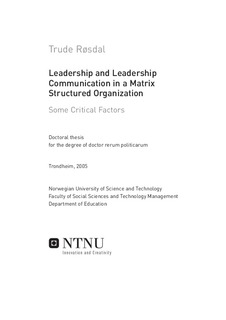| dc.description.abstract | This case study has shown how nearly every success and failure in the matrix structured Segment X was a result of leadership behaviour. If Project I was to be an unreserved success every leader on every level had to succeed in their efforts. After having interviewed employees and leaders, and observed several meetings the overall impression was of a well-functioning, mature matrix organization. However, it is not correct to say that Project I was an unreserved success. There were some areas within the matrix structure that appeared to be more troublesome than others. After having examined each of the seven related research questions the main research question should be answered: What constitutes an effective Norwegian matrix organization in terms of communication and leadership as perceived by its members/employees? In order for a leader in the matrix organization to succeed on a general level, it was perceived that he or she should be emotionally intelligent and possess social and communication skills. Communication skills that in particular were suggested to be of great importance were the ability to create a sense of commitment to organizational goals in each employee, and to be able to persuade the employees to reach set goals in time. Employees increasingly no longer ask “What should I do?” but “Why should I do it?”, and persuasion seemed in fact to be one of the more difficult aspects for the leaders of Segment X. Extensive interpersonal and communication skills were also perceived to be of great importance to meet the challenges of the matrix structure. The main challenge associated with the matrix structure was the distribution of resources. In order to handle this challenge in an effective way and avoid conflicts, respect for the current rules was pointed to as crucial by both functional and project leaders.
In general the most obvious challenge for Segment X and in particular Project I was the teams and the management of teams. The two teams of special interest in this case study experienced some serious problems. Team management and the composition of the teams were the main reasons that the teams struggled. Both these issues will be the responsibility of the functional management. Thus in a matrix structured organization where the use of work teams is necessary it is of great importance to in a more thorough way evaluate both the skills and style of the potential team leader and also consider the composition of the team. Since teams actually carry out the projects of the matrix organization, the effectiveness of the matrix organization is more or less dependent on well functioning teams.
The truly effective matrix organization is constituted first of all of socially skilled leaders on all levels who are effective persuaders, who are willing to respect the formal rules of the matrix structured organization, and who are able to alter their leadership style depending on the context. All this highlights the importance of and need for a stronger focus on leader communication and behaviour.
The results from this case study conducted in a Norwegian organization do not differ to any great extent from the findings of other relevant studies conducted in other countries (the literature reviewed in this thesis is mainly from English speaking countries). However, it does seem like the Norwegian organization (Segment X), and in particular in relation to Project I (as Project I formed the basis for this study) is a well functioning matrix organization, that has stared clear of some of the most obvious challenges mentioned by other research into matrix organizations. For instance the multiple reporting relationships that exist within a matrix organization were not mentioned to any great extent, neither by the leaders nor by the employees of Segment X.
In relation to further or future research within the area of organizational structure, leadership and leadership communication, several suggestions can be made. For this organization in particular it would be of value to conduct more research into the use of teams. As the teams are so important in a matrix structured organization like Segment X, more knowledge should be gained about the factors that will impact on the effectiveness of the team. One other question that could be raised is whether the necessary leadership skills and leadership communication will differ within a production oriented company compared to an innovation oriented company.
It is also of interest to be able to discuss why or if there are differences between a Norwegian matrix organization in terms of leadership and leadership communication, and matrix organizations in other countries. Future research will also benefit from using both qualitative and quantitative approaches, maybe especially in relation to investigate how communication skills of leaders are related to the feeling of commitment in the employees. | nb_NO |
